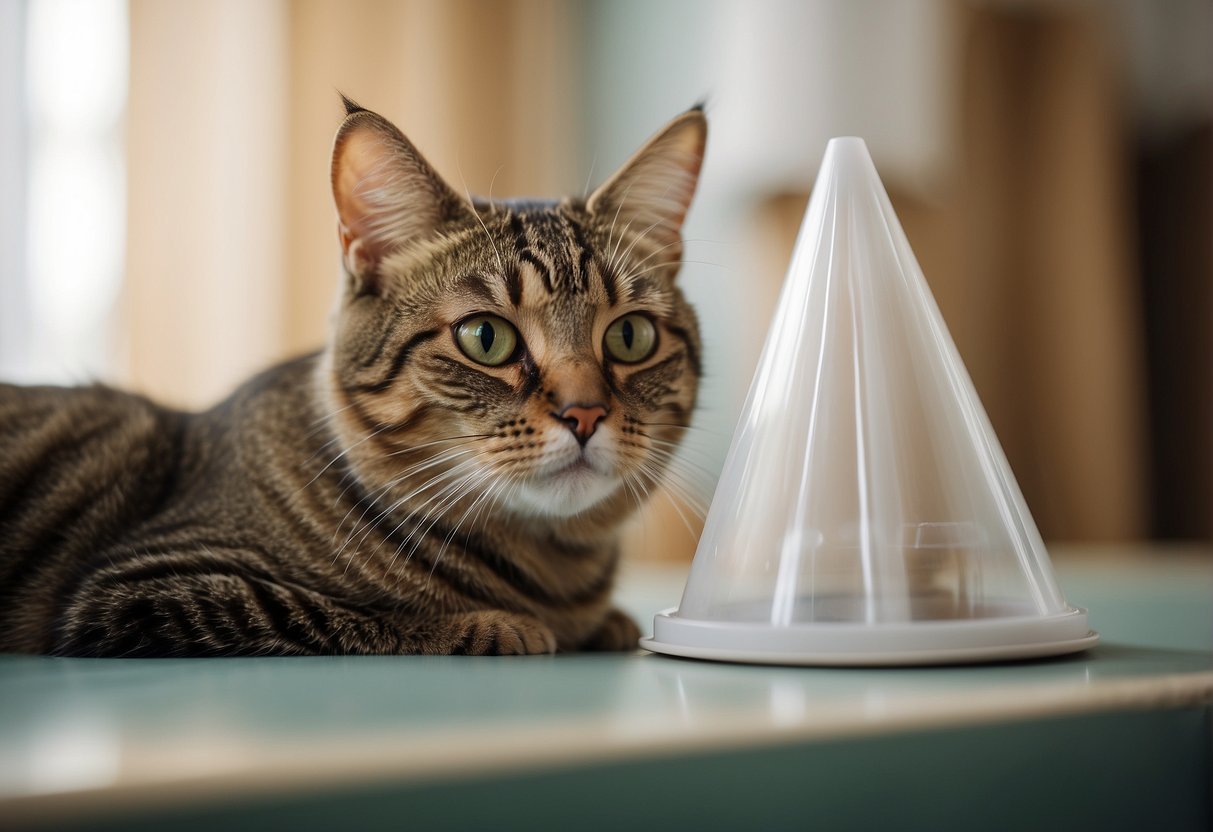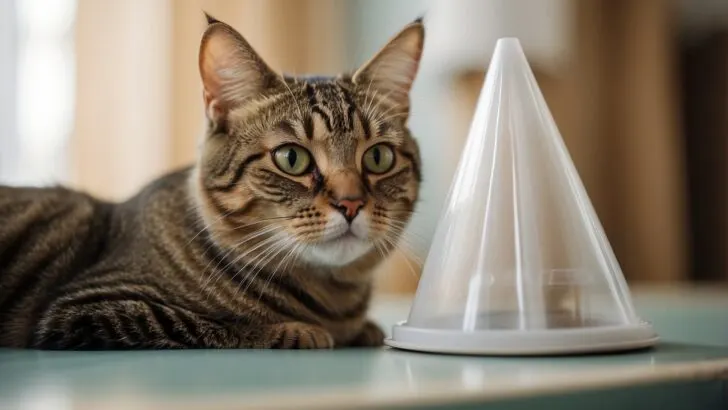After your cat has undergone surgery, such as a spay or neuter, it’s critical to keep the cone on for at least 10-14 days. This time frame allows the incision to heal sufficiently and reduces the risk of your cat licking or biting at the stitches or the wound.
In practice, this means observing your cat’s behavior closely—if they show any interest in grooming or scratching at the surgery site, the cone is doing its essential job. While it might look a bit funny, the cone is an important safeguard to prevent potential infections or reopened wounds.
Maintaining the cone on your furry companion can be challenging, especially when they give you those big, sad eyes or seem to struggle with daily activities. Your cat might bump into furniture or have difficulty navigating their usual haunts at first, but most adapt fairly quickly.
Remember, the cone is temporary and it’s all for their well-being. Each cat’s recovery can be a little different, so always follow your vet’s specific recommendations regarding the post-operative period
The Purpose of the Cat Cone

The cat cone is essential after surgery to prevent your furry friend from tampering with their incision site, ensuring a smooth and infection-free healing process.
Elizabethan Collar vs. Soft Cone
The Elizabethan collar, commonly known as the traditional cat cone, is a rigid, lampshade-like structure that fits around your cat’s neck.
Its rigid design effectively blocks access to surgery sites. On the other hand, a soft cone is made from pliable materials like fabric, which can make it more comfortable for your cat to wear. Both types serve the same purpose: to prevent your cat from licking or biting at their wounds.
However, the best choice depends on your cat’s temperament and the location of the incision.
Cone of Shame: Protecting the Incision Site
The cone, affectionately dubbed the “cone of shame,” is critical for protecting the incision site post-surgery.
Without it, your cat might lick or bite the area, introducing bacteria that can lead to infection. By creating a physical barrier, the cat cone keeps the healing process on track — no scratching, no licking, and no potential complications from those sharp little teeth getting too curious about the stitches.
Positive Impact on Healing Process
A properly fitted cone can have a positive impact on the healing process, helping ensure your cat recovers quickly and without incident. It’s vital to keep the cone on for the recommended duration, which usually ranges between 10 to 14 days.
This period allows the incision to heal sufficiently and reduces the risk of reopening the wound, which could necessitate a return trip to the vet. Your patience and attentiveness during this time is crucial for your cat’s well-being.
Post-Surgery Recovery Guidelines
After your cat has undergone surgery, ensuring a safe and swift recovery is crucial. Proper cone usage is an integral part of preventing your cat from licking or chewing at stitches or sutures, which can lead to infection or injury.
Determining the Duration of Cone Use
Your veterinarian will provide specific guidelines for how long the cone—often called the “cone of shame”—should remain on your cat.
Recovery time usually ranges from 10 to 14 days, depending on the nature of the surgery and how fast the sutures or staples dissolve. It’s important to follow their advice closely, even if your cat seems uncomfortable.
Monitoring Cat Behavior with the Cone
Cats typically exhibit various behaviors with the cone that you should monitor. Make sure that your cat isn’t excessively licking or chewing at the cone, which can signal discomfort or distress. Observe how your cat navigates space with the cone on, ensuring they’re not bumping into objects or struggling to rest comfortably.
Handling Food and Water
Adjusting how your cat eats and drinks with the cone is essential. Provide water and food in shallow bowls to make access easier. You might notice your cat’s behavior around meals change, as the cone can make the simple act of eating an ordeal.
Be patient and troubleshoot with different bowl placements or cone adjustments to find what works best for your feline friend’s comfort and to prevent spilling or messes.
Potential Complications and Comfort Tips
After your cat’s surgery, managing their recovery is vital to prevent complications and ensure they remain as comfortable as possible. Let’s cover how you can look after your cat’s health, spot issues early, and select the best cone alternative if needed.
Minimizing Discomfort and Ensuring Health
Your cat’s well-being after surgery hinges on them not interfering with the incision site. You can make the cone period less stressful by:
- Providing a comfortable cat bed that accommodates the cone
- Keeping food and water in easily accessible areas
- Restricting jumping by removing high perches to avoid strain
Signs of Infection and When to Contact the Vet
Keep an eye out for red flags such as redness, swelling, or discharge at the incision site, all of which may indicate infection. Excessive lethargy or changes in behavior can also signal problems. If you spot these signs, don’t hesitate to reach out to your vet. Early detection is crucial in managing your cat’s health post-operation.
Cone Alternatives and How to Choose the Right One
If your cat absolutely cannot tolerate their cone, there are alternatives for keeping their recovery on track. Options include:
- Fabric cones, which are softer and may cause less irritation
- Recovery suits, providing full-body protection
- Calming pheromones, which can help to reduce anxiety and discourage scratching
When choosing an alternative, consider your cat’s temperament and the surgery’s nature. For instance, a very active cat might do better with a snug recovery suit that doesn’t impede movement as much as a cone.
Adjustment Period and Considerations
After your cat undergoes surgery, they will need a period of adjustment to their new temporary accessory: the cone. It’s crucial for your cat’s recovery to ensure they get used to wearing the cone and can still manage their daily activities with minimal stress.
Acclimating Your Cat to the Cone
Helping your cat get comfortable with the cone is essential. Start by introducing the cone in a calm environment and allowing your cat to sniff and explore it.
Place it loosely at first, and gradually tighten it to the recommended security so they can’t pull it over their head. Comforting your cat and offering treats can associate the cone with positive experiences. Remember, their vision will be obstructed, which may initially cause confusion, but many cats adapt quickly.
Impact on Everyday Activities
A cat with a cone will experience challenges during their regular routine. Grooming will be restricted, which can be frustrating, so you might need to help with a soft, damp cloth around their face and paws. Regarding their litter box, ensure it’s large enough to accommodate the extra space the cone requires.
Many cats might have difficulty walking or crawling under furniture, so remove obstacles and provide a clear path. To keep their minds active, consider interactive toys that don’t require them to use their heads extensively during play.

My name is James, and welcome to FAQCats!
Along with our team of cat owners, expert pet enthusiasts, and pet professionals, we aim to write engaging helpful, engaging content about cats. At FAQCats we strive to provide content that’s accurate and fun to read. Our team writes about everything related to cats; even the most complex of topics. Through extensive research and caring for our own fur-pals, we’re able to provide something cat owners worldwide will love. Have a look around, and leave us feedback anytime!

